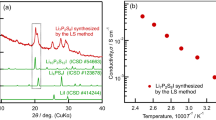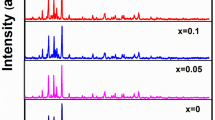Abstract
Lead zirconate titanate powders are derived from a novel aqueous-based citrate-nitrate/oxynitrate sol-gel combustion process. Aqueous solutions of metal nitrates or oxynitrates are transformed into gels with citric acid under heating. The received gels undergo a self-propagating combustion reaction on heating to 180 °C and subsequently yield voluminous ashes. These ashes form single phase perovskite Pb(Zr0.53Ti0.47)O3 powder with a specific surface area of 8 m2/g upon calcination at 550 °C. The ashes show a homogeneous distribution of lead, zirconium, and titanium ions which guarantees short diffusion paths in solid state formation of PZT perovskite. The redox behavior of the gels was studied with the help of DTA experiments. Powders are characterized in terms of XRD, SEM, and EDX analysis.
Similar content being viewed by others
References
B. Jaffe, W. R. Cook, and H. Jaffe, Piezoelectric Ceramics (Academic Press, New York, 1971).
W. Wersing, W. Rossner, G. Eckstein, and G. Tomandl, Silicates Industriels 3–4, 41–46 (1985).
T. R. Shrout, P. Papae, S. Kim, and G. Lee, J. Am. Ceram. Soc. 73 (7), 1862–1867 (1990).
S. S. Chandratreya, R. M. Fulrath, and J. A. Pask, J. Am. Ceram. Soc. 64 (7), 422–425 (1981).
M. Kulig, G. Preu, D. Cramer, and K. Lubitz, Ceramics: Charting the Future, edited by P. Vincenzini (Techna, 1995), pp. 2493–2498.
H. Cheng, J. Ma, B. Zhu, and Y. Cui, J. Am. Ceram. Soc. 76 (3), 625–629 (1993).
K. D. Budd, S. K. Dey, and D. A. Payne, Brit. Ceram. Soc. Proc. 36, 107 (1985).
G. Yi and M. Sayer, J. Sol-Gel Sci. Technol. 6, 65–74 (1996).
C. D. E. Lakeman, J-F. Campion, and D. A. Payne, Ferroelectric Films, 413–439 (1992).
W. Zhu, Z. Q. Liu, M. S. Tse, W. Lu, and H. S. Tan, Integrated Ferroelectrics 9, 95–104 (1995).
John Thomson, Jr., Ceram. Bull. 53 (5), 421–425 (1974).
P. Ari-Gur and L. Benguigui, Solid State Commun. 15, 1077–1079 (1974).
L. Hahn, K. Uchino, and S. Nomura, Jpn. J. Appl. Phys. 17 (4), 637–641 (1978).
S. A. Mabud, J. Appl. Cryst. 13, 211–216 (1980).
K. Kakegawa, J. Mohri, S. Shirasaki, and K. Takahashi, J. Am. Ceram. Soc. 65 (10), 515–519 (1982).
S. Roy, A. Das Sharma, S. N. Roy, and H. S. Maiti, J. Mater. Res. 8, 2761–2766 (1993).
S. Roy, W. Sigmund, and F. Aldinger, unpublished.
Author information
Authors and Affiliations
Rights and permissions
About this article
Cite this article
Schäfer, J., Sigmund, W., Roy, S. et al. Low temperature synthesis of ultrafine Pb(Zr, Ti)O3 powder by sol-gel combustion. Journal of Materials Research 12, 2518–2521 (1997). https://doi.org/10.1557/JMR.1997.0333
Received:
Accepted:
Published:
Issue Date:
DOI: https://doi.org/10.1557/JMR.1997.0333




